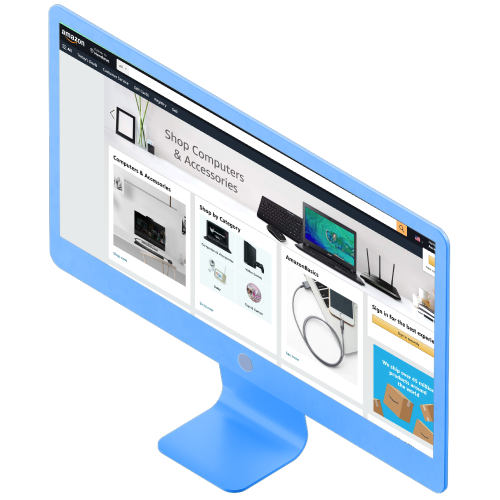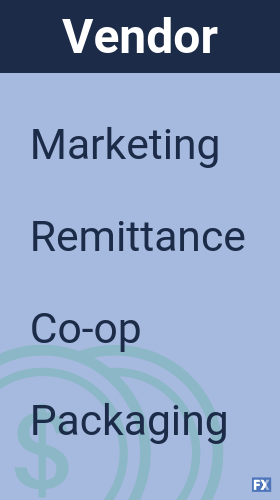-
 12 min. read
12 min. read
-
 Sarah Berry
Sarah Berry Lead Web Marketing Consultant
Lead Web Marketing Consultant
- Sarah Berry is a Lead Web Marketing Consultant at WebFX. With more than 10,000 hours of experience, she offers practical insights and strategies you can use to grow your digital revenue. When she isn’t polishing her Time Magazine Person of the Year Award, she’s spending time with her flock of ducks.
Receiving over 2 billion visitors each month, Amazon offers access to a tremendous number of shoppers. Selling on Amazon, however, introduces several challenges, including becoming a part of the Amazon Vendor Central program. While all businesses start in Amazon Seller Central, only a few receive invites to Vendor Central.
The question is, should you join this program if you have the chance? With this helpful Amazon Vendor Central vs. Amazon Seller Central guide, you can make an informed decision when it comes to selling on Amazon. Keep reading to learn more about the differences between these two platforms, from their payment plans to their management requirements. If you’re looking to make the most of your Amazon presence, whether with more sales, better search rankings, or improved ad performance, WebFX can deliver the support, know-how, and results you need.
Contact us online or call us at 888-601-5359 to learn more about our Amazon services!
The first step to increasing your SMB’s Amazon sales is getting a FREE proposal.
One of our experts will be in touch within 24 hours!

Your quick summary to Amazon Vendor Central vs. Amazon Seller Central
Need to know the differences between Amazon Vendor Central vs. Amazon Seller Central now? Check out this handy table, which breaks down the differences between these two programs:
| Feature | Amazon Vendor Central | Amazon Seller Central |
| User | Distributor or Manufacturer | Seller or Retailer |
| Access | Invite-only | Anyone |
| Customer | Amazon | Amazon shoppers |
| Product price | Set by Amazon | Set by seller |
| Support | Dedicated account manager | Seller Support |
| Fees | Marketing, remittance, co-op, and packaging fees | $0.99 to $39.99 /mo., plus referral and variable closing fees |
| Payment | 2/30 Net 31, 1/60 Net 61, or Net 90 | Every 7 to 14 days |
| Inventory management | Distributor and Amazon | Seller and Amazon |
| Order fulfillment | Amazon | Seller or Amazon |
| Customer service | Amazon | Seller or Amazon |
| Marketing | A+ Enhanced Marketing Content and Amazon Vine | Enhanced Brand Content and Amazon Early Reviewer Program |
What is Amazon Vendor Central?
Amazon Vendor Central is an invite-only program and platform for manufacturers and distributors operating on Amazon. Members of Amazon Vendor Central sell and supply their products to Amazon, which Amazon then resells under its name.
What is Amazon Seller Central?
Amazon Seller Central is a free-to-join program and platform for businesses and individuals operating on Amazon.
Members of Amazon Seller Central sell their products to Amazon shoppers directly or via programs like Fulfillment by Amazon (FBA). A free or paid version of Amazon Seller Central is available.
11 core differences between Amazon Vendor Central vs. Amazon Seller Central
While Amazon Vendor Central and Amazon Seller Central revolve around Amazon, they feature defining differences. As a business using Amazon, understanding the differences between the two is a critical part of your manufacturer and distributor marketing solutions, especially if you receive an invite to Amazon Vendor Central. When it comes to Amazon Vendor Central vs. Amazon Seller Central, there are 11 core differences:
1. User
The most significant separation between these two platforms is who uses them:
Amazon Vendor Central Amazon Vendor Central focuses on first-party vendors. These are companies that can produce or acquire, as well as supply products in bulk. That’s why manufacturers and distributors often receive offers to become a part of the Amazon Vendor Central program.
Amazon Seller Central Amazon Seller Central revolves around second- and third-party vendors.
These vendors can range from businesses to individuals. While some members of Amazon Seller Central sell professionally, others do recreationally. That’s why Amazon Seller Central features a free version and a paid subscription.
2. Access 
The ability to access these two platforms is another key differentiator:
Amazon Vendor Central Amazon Vendor Central operates on an invite-only model. Your business can only become a part of the program if you receive an invite from Amazon. In most cases, Amazon will deliver these invitations via email.
Companies that obtain invites generally post a significant number of sales and revenue.
Amazon Seller Central Amazon Seller Central allows anyone to sign-up and sell on Amazon. Users can choose between the free Individual Plan or the $39.99 per month Professional Plan. No matter which plan a business or individual selects, they will need to pay Amazon sale and selling fees, which range from referral costs to variable closing fees.
3. Customer
Who you sell to also changes with Amazon Vendor Central and Amazon Seller Central:
Amazon Vendor Central As a member of Amazon Vendor Central, your business will have only one customer: Amazon. That’s because, as a manufacturer or distributor, your company supplies Amazon with your product. Amazon then handles the process of listing, managing, marketing, and shipping your products to shoppers.
Amazon Seller Central As a member of Amazon Seller Central, your business will have an infinite number of customers.
Since your company sells to shoppers directly, you will have a customer-facing role. Your team will need to add and update your product listings, as well as handle any marketing or advertising campaigns. Depending on your strategy, your business or Amazon may take care of fulfilling product orders.
4. Product pricing
Pricing is another significant difference between Amazon Vendor Central and Amazon Seller Central: 
Amazon Vendor Central With Amazon Vendor Central, Amazon manages your product pricing on Amazon.com. When you become a part of Amazon Vendor Central, your business sets a minimum advertising price (MAP). Amazon will then adapt this rate to generate and maximize sales.
It’s essential to mention that many sellers report that Amazon does not always adhere to MAP requests.
Amazon Seller Central With Amazon Seller Central, your business controls your product pricing on Amazon.com. Whether you want to increase or decrease your prices, run a limited-time promotion, or launch a coupon, you have complete control as a member of Amazon Seller Central. This freedom tends to serve as a frequently mentioned perk in debates between Amazon Seller Central vs Amazon Vendor Central.
5. Support
The support offered to your business by Amazon is another difference worth mentioning:
Amazon Vendor Central Amazon Vendor Central provides your company with a dedicated account manager. This account manager serves as a point-of-contact for your business. Whether you have questions about your account or features of Amazon Vendor Central, you can ask your account manager.
Companies that use Amazon Vendor Central, however, report mixed experiences when it comes to account managers.
Amazon Seller Central Amazon Seller Central includes support services that businesses and individuals can access. In addition to an online forum, sellers can submit tickets and other requests to Amazon. The massive number of Amazon Seller Central memberships requires Amazon to deliver a helpful and seamless experience for sellers.
It’s also why many users report a positive experience with the support system.
6. Fees
Fees also differ substantially between Amazon Seller Central and Amazon Vendor Central:
Amazon Vendor Central In Amazon Vendor Central, your business must pay the following fees to Amazon: 
- Marketing: Your marketing fees encompass any advertising or marketing that Amazon does to promote and sell your product.
- Remittance: Your remittance fees include any costs for transferring funds from Amazon to your business.
- Co-op: Your co-op fee covers the cost of Amazon hosting your product, as well as crediting it as being shipped and sold by Amazon. Essentially, your co-op fee is what your business pays to benefit from the Amazon brand.
- Packaging fees: Your packaging fees include the cost of Amazon picking and packing your products for order fulfillment and shipment.
These fees can range on a month-to-month basis. This fact can complicate your bottom line because product sales and product prices will vary each month. If Amazon doesn’t sell enough of your product, you may have to pay more than you earned.
Amazon Seller Central In Amazon Seller Central, you will have the following fees to pay:
- Referral fees: Your referral fee is a percentage of your product’s selling price. It can include the cost of gift wrapping, if selected by the shopper. Amazon charges a referral fee because it hosts your products on its platform and connects you with shoppers.
- Variable closing fees: Your variable closing fee depends on the product sold, whether media or non-media. While media products incur a flat-rate fee, non-media products receive a fee based on product type and product weight. Amazon charges this fee to cover closing costs.
If you choose the Individual Plan, you will also pay $0.99 per item sold. Businesses that pick the Professional Plan, in comparison, will pay $39.99 per month instead. In addition to waiving the $0.99 per item fee, the Professional Plan also unlocks additional features, including new product categories.
7. Payment
Payments also happen differently for Amazon Vendor Central and Amazon Seller Central members:
Amazon Vendor Central As an Amazon Vendor Central, you will choose from one of the following payment options:
| Payment Terms | Details |
| 2/30 Net 31 | Amazon will get a 2% discount on their payment when paying you within 30 days. Otherwise, you will receive your full payment within 31 days for the pay period. |
| 1/60 Net 61 | Amazon will get a 1% discount on their payment if they pay you within 60 days. Otherwise, you will receive full payment within 61 days for the pay period. |
| Net 90 | Amazon will provide full payment within 90 days for the pay period. |
When you become a part of Amazon Vendor Central, your business will need to choose one of these options.
This option then becomes the default payment term. For the best experience and results, your company must research your choice in-depth to avoid cash-flow problems.
Amazon Seller Central As an Amazon Seller Central member, you can expect payment every seven to 14 days. Payments from Amazon may appear as from either Amazon Payments, Inc.
or Amazon Services LLC. Amazon Payments, Inc. delivers payment when buyers pay on or before order shipment.
In comparison, Amazon Services LLC provides payment when buyers pay after order shipment.
8. Inventory management
Inventory management also varies for Amazon Vendor Central and Amazon Seller Central members:
Amazon Vendor Central Members of Amazon Vendor Central must supply Amazon with products, as well as take a proactive approach to inventory management. That’s because Amazon sells a tremendous number of products from Amazon Vendor Central members fast, which can result in delayed notices for low inventory.
Amazon Seller Central Members of Amazon Seller Central maintain complete control over inventory management, unless using FBA. If you control your inventory, it’s usually easier for you to monitor inventory and ensure you stay stocked for shoppers.
In comparison, with FBA, you will need to coordinate with them.
9. Order fulfillment
Order fulfillment also separates Amazon Vendor Central and Amazon Seller Central:
Amazon Vendor Central With Amazon Vendor Central, your business acts as a supplier to Amazon. You do not manage or fulfill orders from Amazon.com. Instead, Amazon takes care of the entire order fulfillment process, which makes working as an Amazon Vendor Central member convenient.
Amazon Seller Central With Amazon Seller Central, your business can approach order fulfillment in two ways.
You can package and ship orders in-house, or you can partner with FBA, which takes care of order fulfillment, as well as product returns and refunds for you. FBA does come with monthly storage, picking, and packaging fees.
10. Customer service
Companies will also notice a difference when it comes to providing customer service to shoppers: 
Amazon Vendor Central Since Amazon Vendor Central works with Amazon directly, they do not have to provide customer support to Amazon.com shoppers. Instead, your customer is Amazon.
Your team may work with a variety of Amazon team members to keep inventory stocked, discuss payment terms, and more.
Amazon Seller Central Since Amazon Seller Central works with Amazon.com shoppers directly, they need to offer customer support. For example, your team will want to respond to customer reviews, handle returns, and more. If you use FBA, however, that services will take care of returns, refunds, and customer inquiries.
11. Marketing
Marketing also separates Amazon Vendor Central and Amazon Seller Central from one another:
Amazon Vendor Central As an Amazon Vendor Central member, Amazon markets your products on Amazon.com for you. That allows Amazon to take advantage of additional features for products, like A+ Enhanced Marketing Content for product listings and Amazon Vine for product reviews.
Amazon Seller Central As an Amazon Seller Central member, your business (or your ad agency for Amazon) takes care of managing and marketing your products on Amazon.com. You can access a few different features, like Enhanced Brand Content for your product listings and the paid Amazon Early Reviewer Program for product reviews.
Whether you’re a part of the Amazon Seller Central or Amazon Vendor Central platform, it’s essential to understand the differences between these two programs. That way, you can choose the best one for your business, even if it means leaving one program for another or staying in your current one.

Get an instant breakdown of your Amazon sales margin with our free calculator.
Learn More
Do you want to earn more revenue from Amazon?
Amazon remains the world’s biggest ecommerce platform, offering companies of all sizes the opportunity to reach a massive audience, build their brand, and accelerate their product sales to new levels. With more than one million small-to-midsized businesses (SMBs) selling on Amazon, though, it’s challenging to get in front of shoppers.
Launching a competitive marketing and advertising campaign, however, can change that. At WebFX, we help companies from a range of industries sell on Amazon successfully. Our decades of experience, plus advanced artificial intelligence tech, allows us to create ad campaigns with a low cost per sale and build marketing strategies that help your business reach shoppers looking to buy.
Browse our marketing for Amazon and advertising services to learn more about how we can help, or learn more about our Seller tipsn for Amazon!
-
 Sarah Berry is a Lead Web Marketing Consultant at WebFX. With more than 10,000 hours of experience, she offers practical insights and strategies you can use to grow your digital revenue. When she isn’t polishing her Time Magazine Person of the Year Award, she’s spending time with her flock of ducks.
Sarah Berry is a Lead Web Marketing Consultant at WebFX. With more than 10,000 hours of experience, she offers practical insights and strategies you can use to grow your digital revenue. When she isn’t polishing her Time Magazine Person of the Year Award, she’s spending time with her flock of ducks. -

WebFX is a full-service marketing agency with 1,100+ client reviews and a 4.9-star rating on Clutch! Find out how our expert team and revenue-accelerating tech can drive results for you! Learn more
Try our free Marketing Calculator
Craft a tailored online marketing strategy! Utilize our free Internet marketing calculator for a custom plan based on your location, reach, timeframe, and budget.
Plan Your Marketing Budget

Proven Marketing Strategies

Proven Marketing Strategies
Try our free Marketing Calculator
Craft a tailored online marketing strategy! Utilize our free Internet marketing calculator for a custom plan based on your location, reach, timeframe, and budget.
Plan Your Marketing Budget
What to read next





